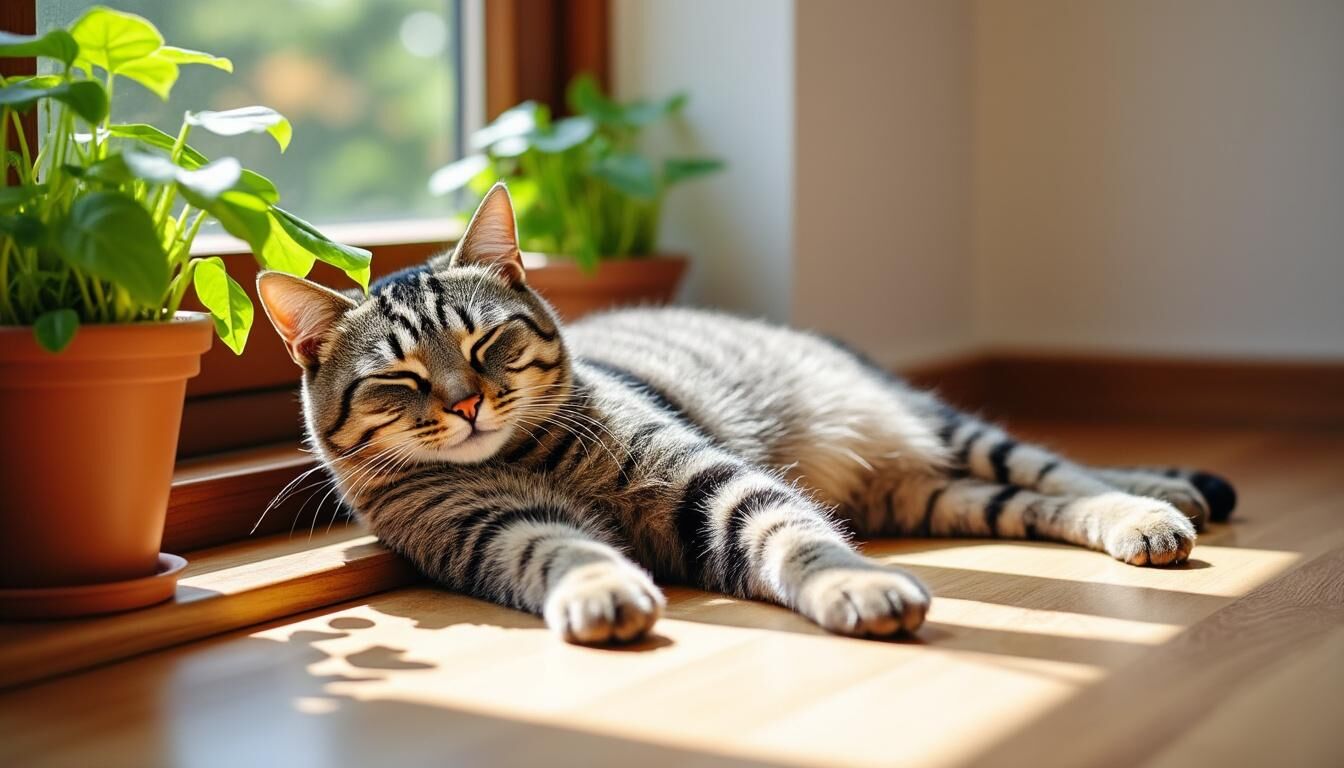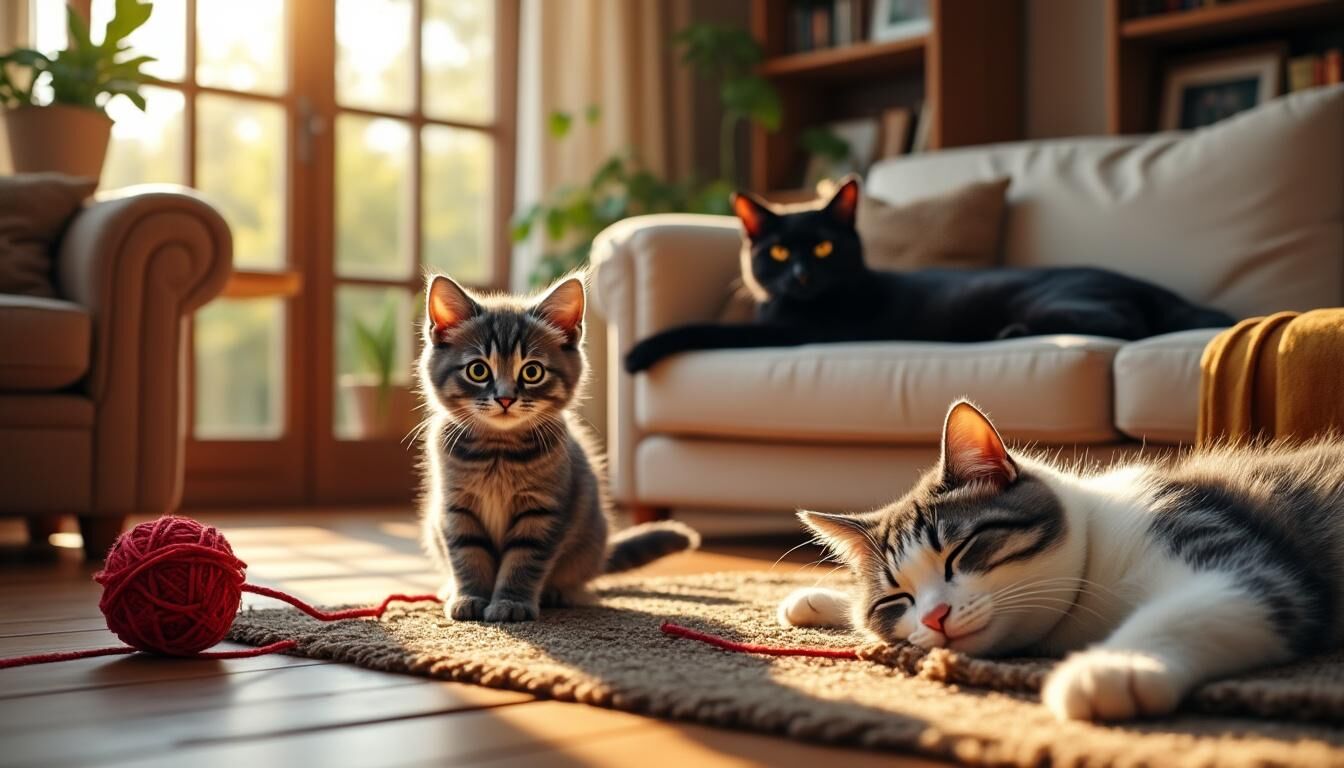How long do cats live? This question intrigues countless cat owners and enthusiasts, highlighting the complexity behind feline life expectancy. The lifespan of cats varies widely depending on numerous factors, prominently whether a cat lives primarily indoors or outdoors. Statistics show that indoor cats tend to live significantly longer, often reaching between 9 to 17 years, while outdoor cats face a much harsher reality, with an average lifespan often around 5 years. The reasons lie mainly in exposure to accidents, infectious diseases, predators, and environmental stressors that outdoor cats face daily. However, this fundamental divide is just the start; genetics, diet, healthcare, and the level of human care also play critical roles in shaping the individual destiny of a cat’s lifespan.
The subtle nuances of feline longevity involve understanding not only biological predispositions but also the everyday lifestyle that influences their health and wellbeing. For instance, indoor cats benefit from reduced risks, controlled environments, and regular preventive veterinary care, including vaccinations and parasite control. Outdoor cats, meanwhile, confront natural hazards like traffic accidents, fights with other animals, and exposure to parasites and infectious diseases. These circumstances substantially curtail their average life expectancy.
Key contributors include breed-specific risks and genetic factors, as well as the quality of nutrition and environmental enrichment. Recent studies highlight that mixed-breed cats often enjoy superior longevity compared to some purebreds, suggesting hybrid vigor plays a protective role. Meanwhile, breeds like the Siamese are known for their remarkable lifespan and relative resilience to certain genetic issues. Proper diet and ongoing health practices also directly influence longevity, with high-protein, low-carbohydrate feeding regimens promoting optimal organ function and weight management.
With diligent care, monitoring for signs of aging, and maintaining preventive routines, cat owners can profoundly impact their pet’s life duration. This comprehensive exploration will shed light on all these facets, guiding owners to help their beloved cats live longer, healthier lives in an ever-changing environment. 🐱⌛
Average Cat Lifespan: How Long Do Indoor and Outdoor Cats Live?
Typical Lifespan of Indoor Cats: Years You Can Expect
Indoor cats generally enjoy one of the longest lifespans among domestic animals. Protected from external hazards, the average indoor cat lives between 9 to 17 years, with many cats reaching their early to mid-teens. Factors such as a stable diet, controlled temperature, and prevention of trauma all contribute favorably to their life expectancy. Cozy homes provide shelter from predators, accidents, and diseases, which tend to shorten lifespan in outdoor environments.
Many indoor cats even surpass the typical lifespan, occasionally living beyond 20 years. The certainty of predictable care, absence of environmental stress, and early detection of health concerns due to regular human interaction supports their longevity. Regular exercise and environmental enrichment are also crucial in maintaining both their physical and mental health, which directly affects how long they live.
-
🏠 Average expected lifespan: 9–17 years
-
🩺 Benefits from regular health checkups and vaccinations
-
🥗 Controlled diet tailored for life stage and health status
-
🧩 Reduced stress and injury risk from urban or indoor environment
-
🚪 Limited exposure to infectious diseases and parasites
|
Condition |
Indoor Cats |
Outdoor Cats |
|---|---|---|
|
Average Lifespan (years) |
9–17 🐾 |
~5 🐾 |
|
Risk of Trauma |
Low |
High ⚠️ |
|
Exposure to Infectious Diseases |
Minimal |
Elevated ⚠️ |
|
Predation Threat |
None |
Significant ⚠️ |
|
Routine Veterinary Care |
Consistent |
Often Irregular |
How Long Do Outdoor Cats Usually Live? Key Survival Differences Explained
Outdoor cats face a much different reality compared to their indoor counterparts. With an average life expectancy of only about 5 years, outdoor cats encounter a wide spectrum of threats that unpredictably shorten their lifespan. Traffic accidents, attacks by other animals, exposure to poisons and infectious diseases such as feline leukemia virus (FeLV) and feline immunodeficiency virus (FIV), greatly increase mortality risk.
These cats also face harsher environmental conditions, fluctuating temperatures, and challenges in finding balanced nutrition unless supplemented by human owners. The cumulative effect of these hazards results in a drastically reduced lifespan compared to indoor cats. However, some outdoor cats may survive and thrive beyond expectations, especially if they receive periodic veterinary care or live in safer suburban or rural environments.
-
🌳 Average lifespan: approximately 5 years
-
🚗 High risk of trauma due to vehicle traffic
-
🐾 Potential exposure to predation or fights with other animals
-
🦠 Greater vulnerability to contagious diseases and parasites
-
🍂 Challenging access to balanced nutrition and water
Top Factors Responsible for Differences in Cat Lifespan
The divide in lifespan between indoor and outdoor cats primarily stems from environmental risks and healthcare accessibility:
-
⚠️ Exposure to hazards: Outdoor cats face trauma from vehicles, predators, and fights causing injuries that often prove fatal.
-
🦟 Parasites and infectious diseases: Outdoor cats encounter ticks, fleas, and viral infections that indoor cats rarely contract.
-
🍽️ Nutrition inconsistency: Outdoor cats may rely on scavenging or inconsistent feeding schedules, impacting their overall health.
-
🏥 Healthcare access: Indoor cats benefit from routine veterinary care, vaccination, and early disease detection, which extends lifespan.
-
🏠 Climate and shelter: Indoor cats live in thermally controlled, safe environments, whereas outdoor cats endure weather extremes and lack protection.
|
Factor |
Impact on Indoor Cats |
Impact on Outdoor Cats |
|---|---|---|
|
Environmental Risk |
Minimal 🛡️ |
High ⚠️ |
|
Healthcare Regularity |
Consistent 🩺 |
Irregular |
|
Nutritional Stability |
Optimized 🥗 |
Variable |
|
Exposure to Diseases |
Low |
High 🦠 |
|
Stress and Exercise |
Managed |
Variable |
What Affects a Cat’s Lifespan? Lifestyle, Nutrition, and Health Practices
How Indoor Living Extends Cat Longevity Compared to Outdoor Risks
Living indoors naturally shields cats from many of the external threats that shorten lifespan in outdoor environments. The protective barrier offered by homes eliminates the dangers of road accidents, fights, and parasitic infestations. Moreover, indoor cats often benefit from consistent human interaction, allowing owners to notice early signs of health issues that would otherwise go untreated.
Veterinary care is more accessible for indoor cats, allowing timely vaccinations, parasite prevention, and dental hygiene that contribute to longer life. Indoor living reduces stress linked to territory disputes and predation, which supports a healthier immune system and improves overall well-being. However, indoor cats require mental stimulation and exercise to prevent obesity and boredom, factors key to maintaining a healthy lifespan.
Environmental Dangers and Common Hazards to Outdoor Cats
-
🚙 Traffic-related accidents are leading causes of premature death outdoors.
-
🦗 Parasites such as fleas, ticks, and worms contribute to chronic health problems.
-
😷 Infectious diseases like FeLV and FIV compromise immune systems.
-
🐍 Exposure to toxins and poisons through ingesting hazardous substances or plants.
-
🦊 Attacks from predators or territorial fights can cause fatal injuries.
Crucial Role of a Balanced, Species-Appropriate Cat Diet for Longevity
Nutrition plays a pivotal role in determining a cat’s lifespan. Cats require a diet rich in animal-based proteins and low in carbohydrates to meet their metabolic needs. Proper nutrition sustains organ health, supports immune function, and reduces risks of obesity—one of the most common health problems in domestic cats linked to reduced lifespan.
Feeding a high-quality, species-appropriate diet tailored to the cat’s life stage (kitten, adult, senior) provides essential nutrients for optimal health. Poor diet quality or inconsistent feeding can lead to malnutrition, weight gain, or deficiencies that impair longevity. Additionally, portion control is important to prevent obesity, which predisposes cats to diabetes, heart disease, and joint problems.
-
🍗 High protein content supports muscle mass and overall vitality.
-
🥦 Low carbohydrate intake prevents metabolic imbalances.
-
💧 Hydration through wet food helps kidney and urinary tract health.
-
🍽️ Feeding according to age and health condition optimizes nutrient absorption.
-
⚖️ Weight management is essential for preventing obesity-related diseases.
Preventive Veterinary Care: Dental Hygiene, Parasite Prevention, and Vaccinations
Regular veterinary care is indispensable in extending the lifespan of cats. Many diseases progress silently in cats due to their natural stoicism; only proactive professional assessment can catch early warning signs. Preventive healthcare, including vaccination against common feline diseases and diligent parasite control, protects cats from many life-threatening ailments. Dental care also stands out as crucial since dental disease can lead to systemic infections affecting heart and kidney health.
Frequent veterinary checkups allow early detection of health issues such as thyroid disorders, kidney decline, or diabetes, enabling timely intervention. When combined with consistent monitoring by owners, this approach dramatically improves the quality of life and longevity for cats.
-
🩺 Routine veterinary exams and bloodwork identify emerging problems early.
-
🦷 Dental cleanings and home dental care prevent periodontal disease.
-
💉 Vaccinations reduce incidence of contagious diseases.
-
🦟 Flea, tick, and worm control prevent infestations harmful to health.
-
📋 Behavioral and physical assessments track changes indicating illness.
Do Cat Breeds and Genetics Impact Lifespan?
Breeds Renowned for Exceptional Longevity
Certain breeds have gained recognition for their potential to live longer lives under optimal care. Notably, Siamese cats tend to have a lifespan that often exceeds 15 years, with some individuals surpassing 20 years. Their genetic makeup includes traits linked to strong health and resilience. Other long-lived breeds include Burmese cats, which also showcase notable longevity with proper care.
Breed-specific advantages illustrate how genetics influence lifespan alongside environment and healthcare. Nevertheless, even within long-lived breeds, individual variability remains considerable, influenced by diet, lifestyle, and preventative care.
-
🌟 Siamese: typically 15-20+ years
-
🌟 Burmese: known for robust health and longevity
-
🌟 Ragdoll and Russian Blue also noted for longer lifespans
How Mixed-Breed Cats (Moggies) Often Outlive Purebreds
Mixed-breed cats, often referred to as moggies, frequently benefit from hybrid vigor. This genetic diversity lessens the chance of inheriting breed-specific genetic disorders and leads to generally greater robustness. As a result, moggies often have a lifespan rivaling or exceeding that of many purebred cats, sometimes living well into their late teens.
The reduced prevalence of hereditary diseases and more varied gene pools give moggies an advantage, although this does not negate the importance of proper care and nutrition. Genetics lays a foundation, but environment and lifestyle complete the picture for any cat’s longevity.
-
🔬 Greater genetic diversity resulting in fewer inherited diseases
-
❤️ Often more adaptable to environmental stresses
-
🏃 Benefits maximized with balanced diet and veterinary care
-
⚠️ Still vulnerable to external risks in outdoor conditions
Genetic Disorders and Breed-Specific Health Concerns Affecting Life Expectancy
Certain breeds carry predispositions to specific health issues that can impact lifespan. For example, Maine Coons commonly suffer from hypertrophic cardiomyopathy (HCM), a heart condition that can reduce life expectancy if untreated. Persian cats are prone to respiratory issues due to brachycephalic facial structure, resulting in chronic health challenges impacting longevity.
Recognizing breed-associated risks allows for targeted veterinary monitoring and preventive strategies. Even in breeds with high longevity potential, genetic disorders require early detection and intervention to maximize life expectancy.
-
❤️ Maine Coons: risk of heart disease (HCM)
-
😷 Persians: respiratory and renal issues
-
🦴 Sphynx: susceptibility to skin and temperature regulation issues
-
🧬 British Shorthairs: prone to kidney disease
Understanding Feline Aging: What to Expect as Your Cat Grows Older
Stages of a Cat’s Life: From Kitten to Senior—Life Expectancy at Each Stage
A cat’s life can be broadly divided into stages, each with different care requirements and implications for lifespan. Kittens (0-1 year) grow rapidly, necessitating diets rich in nutrients and frequent veterinary checks. Adult cats (1-7 years) generally enjoy peak health with stable energy requirements. The senior stage (7+ years) marks the beginning of age-related decline, with increased risk for chronic conditions.
Understanding the approximate equivalence of feline and human age helps owners anticipate changes:
|
Cat Age |
Human Equivalent |
Care Focus |
|---|---|---|
|
0-1 year |
0-15 years 👶 |
Growth and vaccinations |
|
1-7 years |
18-44 years 🧑 |
Maintenance nutrition and exercise |
|
7-12 years |
45-64 years 🧓 |
Preventive health screenings |
|
12+ years |
65+ years 👴 |
Management of chronic diseases and comfort |
Recognizing Common Signs of Aging in Cats and How to Respond
Age brings subtle but significant changes in cats that owners should observe carefully. Reduced activity, weight fluctuations, altered grooming, and cognitive shifts may indicate health issues requiring veterinary consultation. Early recognition improves management of conditions like arthritis, dental disease, and renal decline, helping maintain quality of life.
-
🛌 Decreased mobility and joint stiffness
-
⚖️ Weight gain or unintentional weight loss
-
🦷 Dental problems including tooth loss or gum disease
-
🧠 Confusion, disorientation, or altered sleep patterns
-
📉 Changes in appetite or litter box habits
Incredible Longevity in Cats: World Record Holders and What We Can Learn
Extraordinary cases like Creme Puff, a Texas cat who lived to be an astounding 38 years old, illustrate the upper limits of feline longevity. Exceptional genetics combined with meticulous care, diet, and a protected indoor environment made this possible. These cases teach the value of comprehensive healthcare, environmental safety, and attention to the individual needs of cats through all life stages.
While not typical, such records inspire continued advances in feline medicine and owner education, promoting longer and healthier lives for all cats.
Tips to Help Your Cat Live a Longer, Healthier Life
Adopt Lifespan-Boosting Habits: Diet, Enrichment, and Preventive Care
Proactive habits substantially extend cats’ lifespan. Owners should emphasize balanced nutrition tailored to life stage and activity level, provide regular physical and mental exercise through play and environmental enrichment, and engage consistently with veterinary care. Stress reduction and safe indoor living further protect against accidents and diseases.
-
🥗 Feed a high-protein, species-appropriate diet
-
🧩 Provide stimulating toys and interactive play for mental health
-
🩺 Schedule regular veterinary checkups and vaccinations
-
🐾 Create safe indoor environments limiting external risks
-
⚖️ Monitor weight and prevent obesity
Spaying and Neutering: How Reproductive Health Enhances Cat Longevity
Spaying and neutering contribute significantly to increased lifespan in cats by reducing the risk of reproductive cancers and infections. Additionally, neutered cats tend to roam less and exhibit less aggressive behavior, decreasing chances of fights, injuries, and exposure to infectious diseases. This reproductive management aligns with responsible pet ownership that prioritizes a cat’s long-term health.
-
🚫 Reduced risks of uterine, ovarian, and testicular cancers
-
📉 Lower incidence of roaming and fighting behavior
-
🩹 Fewer injuries from territorial disputes
-
🩺 Reduced exposure to infectious diseases linked to mating

Frequently Asked Questions (FAQ)
-
Q: How can I help my outdoor cat live longer? A: Limiting outdoor time, providing vaccinations and parasite prevention, and ensuring balanced nutrition can help extend an outdoor cat’s lifespan. Supervised outdoor access or secure enclosures reduce risks.
-
Q: Are indoor cats prone to obesity? A: Yes, indoor cats may become less active, increasing risk of obesity. Providing regular exercise and portion control with a balanced diet prevents weight-related health problems.
-
Q: Does breed affect how long a cat will live? A: Genetics and breed do influence lifespan. Some breeds, like Siamese, have longer average lifespans, while others face breed-specific health issues. Mixed-breed cats often benefit from hybrid vigor.
-
Q: What are the most important vaccinations for cats? A: Core vaccinations protect against feline panleukopenia, calicivirus, herpesvirus, and rabies. Vaccinations greatly reduce disease risk and improve lifespan.
-
Q: Can dental care really affect a cat’s lifespan? A: Absolutely. Good dental hygiene prevents periodontal disease, which is linked to systemic infections affecting kidneys and heart, thus impacting overall lifespan.

